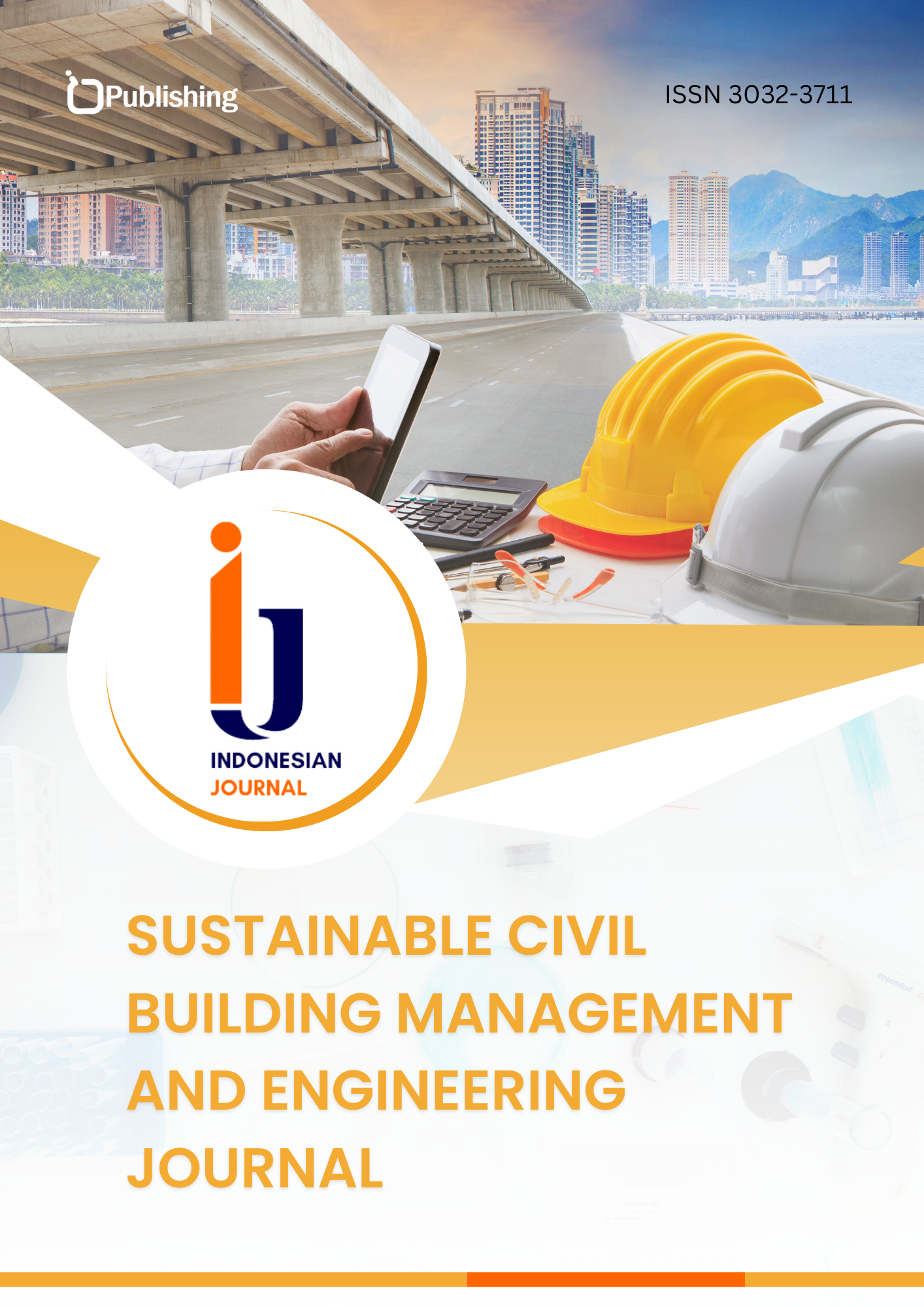Cost Budget Analysis for Equal Distribution of Labour for Multi-Storey Buildings Construction
DOI:
https://doi.org/10.47134/scbmej.v1i3.2439Keywords:
Manpower, Resource Levelling, Cost BudgetAbstract
Although all resources on a construction project have their respective roles, the availability of labour significantly impacts how far the project moves forward and is completed. According to Kastor and Sirakoulis (2009), calculating the number of workers according to the construction schedule is crucial because, without this consideration, the resulting schedule may not be effective and efficient. process used for construction project resources to reduce fluctuations (Waluyo & Aditama, 2017). This research compares labour allocation, duration, and labour wage cost budgets under several conditions. These conditions include actual project conditions, planning, and results after levelling using an auto schedule. In project planning, the fluctuations obtained are pretty sharp. After the auto schedule levelling, the manpower no longer experienced overallocation, but fluctuations between weeks were still relatively high. This can happen because the quantity of work and labour in the construction projects under review is not comparable to the effects of project delays. The results obtained from the comparisons analyzed on the X-storey building construction project are that the auto schedule does not change the initial planning duration, which remains at 133 days. There was a disparity of 0.02% in auto schedule planning costs from 1,098,345,000.00. Meanwhile, in actual conditions, the labour cost budget increased by 0.12% from IDR 967,880,000.00 after the auto-schedule levelling process. It can be concluded that before resource levelling is carried out, it is necessary to review project scheduling and accelerate the duration of implementation, specifically if construction projects experience delays and other factors, so as not to cause fluctuations caused by the uneven quantity of work over some time.
References
Adianto, Y. L. D., & Putro, D. L. (2007). Analisis Resources Levelling Tenaga Kerja. Jurnal Teknik Sipil, 3(2), 113-126. doi:https://doi.org/10.28932/jts.v3i2.1283 DOI: https://doi.org/10.28932/jts.v3i2.1283
Cannavale, A. (2022). Energy and daylighting performance of building integrated spirooxazine photochromic films. Solar Energy, 242, 424–434. https://doi.org/10.1016/j.solener.2021.10.058 DOI: https://doi.org/10.1016/j.solener.2021.10.058
Chen, Z. (2021). Exploration of the multidirectional stability and response of prefabricated volumetric modular steel structures. Journal of Constructional Steel Research, 184. https://doi.org/10.1016/j.jcsr.2021.106826 DOI: https://doi.org/10.1016/j.jcsr.2021.106826
Elhegazy, H. (2022). Artificial Intelligence for Developing Accurate Preliminary Cost Estimates for Composite Flooring Systems of Multi-Storey Buildings. Journal of Asian Architecture and Building Engineering, 21(1), 120–132. https://doi.org/10.1080/13467581.2020.1838288 DOI: https://doi.org/10.1080/13467581.2020.1838288
El-Sayegh, S. (2018). Resource Levelling Optimization Model Considering Float Loss Impact. Engineering, Construction and Architectural Management, 25(5), 639-653. doi:https://doi.org/10.1108/ECAM-10-2016-0229 DOI: https://doi.org/10.1108/ECAM-10-2016-0229
Gauch, H. L. (2023). What really matters in multi-storey building design? A simultaneous sensitivity study of embodied carbon, construction cost, and operational energy. Applied Energy, 333. https://doi.org/10.1016/j.apenergy.2022.120585 DOI: https://doi.org/10.1016/j.apenergy.2022.120585
Jaya, M. N., & Dewi, D. P., A.A. (2012). Analisa Penjadwalan Proyek Menggunakan Ranked Positional Weight Method dan Precedence Diagram Method (Studi Kasus : Proyek Pembangunan Pasar Mumbul Di Kabupaten Buleleng). Jurnal Ilmiah Teknik Sipil. https://ojs.unud.ac.id/index.php/jits/article/view/3457
Kastor, A., & Sirakoulis, K. (2009). The Effectiveness of Resource Levelling Tools for Resource Constraint Project Scheduling Problem. International Journal of Project Management, 27(5), 493-500. doi:https://doi.org/10.1016/j.ijproman.2008.08.006 DOI: https://doi.org/10.1016/j.ijproman.2008.08.006
Kuai, L. (2022). A numerical and experimental investigation of non-linear deformation behaviours in light-frame timber walls. Engineering Structures, 252. https://doi.org/10.1016/j.engstruct.2021.113599 DOI: https://doi.org/10.1016/j.engstruct.2021.113599
Listiani, T., & Kamandang, Z. R. (2023). Analisis Kebutuhan Tenaga Kerja Menggunakan Metode Resources Levelling pada Pekerjaan Struktur Bawah Gedung Bertingkat. Radial: Jurnal Peradaban Sains, Rekayasa dan Teknologi, 11(1), 239-247. https://stitek-binataruna.e-journal.id/radial/article/view/389
Maulana, R., & Sari, S. N. (2024). Analisis Optimalisasi Jumlah Tenaga Kerja Terhadap Time Schedule pada Proyek Rehabilitasi Smp Negeri 2 Wates. Storage: Jurnal Ilmiah Teknik dan Ilmu Komputer, 3(1), 35-44. doi:https://doi.org/10.55123/storage.v3i1.3137 DOI: https://doi.org/10.55123/storage.v3i1.3137
Minarosi, A. A., Putra, I. N. D. P., & Nauli, A. R. (2023). Analisis Resource Levelling pada Tenaga Kerja Studi Kasus: Proyek Jllb Tahap2. Jurnal Ilmiah Mitsu (Media Informasi Teknik Sipil Universitas Wiraraja), 11(1), 83-88. doi:https://doi.org/10.24929/ft.v11i1.2077 DOI: https://doi.org/10.24929/ft.v11i1.2077
Mulyono, M. A., Haryono, I., & Puspita, I. A. (2020). Optimasi Penggunaan Tenaga Kerja Menggunakan Metode Human Resource Levelling pada Proyek Instalasi Optical Distribution Point (ODP). eProceedings of Engineering, 7(1). doi:https://openlibrarypublications.telkomuniversity.ac.id/index.php/engineering/article/view/11896
Peng, J. (2022). Progressive collapse analysis of corner-supported composite modular buildings. Journal of Building Engineering, 48. https://doi.org/10.1016/j.jobe.2021.103977 DOI: https://doi.org/10.1016/j.jobe.2021.103977
Praxedes, C. (2022). Robustness-oriented optimal design for reinforced concrete frames considering the large uncertainty of progressive collapse threats. Structural Safety, 94. https://doi.org/10.1016/j.strusafe.2021.102139 DOI: https://doi.org/10.1016/j.strusafe.2021.102139
Raja, K., & Kumanan, S. (2007). Resource Levelling Using Petrinet and Memetic Approach. American Journal of Applied Sciences, 4(5), 317-322. https://citeseerx.ist.psu.edu/document?repid=rep1&type=pdf&doi=8182a285dbb2aafa821207268ed8d5c932340901 DOI: https://doi.org/10.3844/ajassp.2007.317.322
Retno, D. P., Astuti, A., & Tamimi, Z. (2018). Analisa Penggunaan Sumber Daya Manusia Dengan Metode Resource Levelling pada Pelaksanaan Proyek Konstruksi (Studi Kasus: Proyek Pembangunan Ruang Kelas Baru Ponpes Daarun Nahdah Thawalib Bangkinang). Jurnal Saintis, 18(1), 39-47. DOI: https://doi.org/10.25299/saintis.2018.vol18(1).3194
Sholeha, S., & Kamandang, Z. R. (2024). Analisis Biaya pada Implementasi Resource Levelling Tenaga Kerja. Jurnal Komposit: Jurnal Ilmu-ilmu Teknik Sipil, 8(1), 57-65. https://ejournal.uika-bogor.ac.id/index.php/komposit/article/view/14519
Siswanto, A. B., & Salim, M. A. (2019). Manajemen Proyek: CV. Pilar Nusantara. doi: https://books.google.co.id/books?hl=id&lr=&id=UXYqEAAAQBAJ&oi=fnd&pg=PR5&dq=Siswanto,+Agus+B+Salim,+M+Afif&ots=sYrVkorogE&sig=OWBPGqlmnXzrvgku606adpgukb0&redir_esc=y#v=onepage&q=Siswanto%2C%20Agus%20B%20Salim%2C%20M%20Afif&f=false
Sodikin, I., Hani, S., & Susetyo, J. (2023). Optimization of Multi Contruction Project Implementation with Limited Human Resource, Time, and Capital Using The Resource Levelling Method. Engineering and Technology Journal, 8(09), 2758-2788. doi:https://doi.org/10.47191/etj/v8i9.09 DOI: https://doi.org/10.47191/etj/v8i9.09
Svatoš-Ražnjević, H. (2022). Advanced Timber Construction Industry: A Review of 350 Multi-Storey Timber Projects from 2000-2021. Buildings, 12(4). https://doi.org/10.3390/buildings12040404 DOI: https://doi.org/10.3390/buildings12040404
Ujong, J. A. (2022). Prediction of cost and duration of building construction using artificial neural network. Asian Journal of Civil Engineering, 23(7), 1117–1139. https://doi.org/10.1007/s42107-022-00474-4 DOI: https://doi.org/10.1007/s42107-022-00474-4
Waluyo, R., & Aditama, S. (2017). Pengaruh Resource Levelling Terhadap Alokasi Tenaga Kerja pada Proyek Konstruksi. Jurnal Ilmiah Teknik Sipil, 21(2), 118-128. doi:https://ojs.unud.ac.id/index.php/jits/article/view/33097
Wohon, F. Y., Mandagi, R. J., & Pratasis, P. (2015). Analisa Pengaruh Percepatan Durasi pada Biaya Proyek Menggunakan Program Microsoft Project 2013 (Studi Kasus: Pembangunan Gereja GMIM Syaloom Karombasan). Jurnal Sipil Statik, 3(2). doi:https://ejournal.unsrat.ac.id/index.php/jss/article/view/6870
Ye, J. (2022). An improved and robust finite element model for simulation of thin-walled steel bolted connections. Engineering Structures, 250. https://doi.org/10.1016/j.engstruct.2021.113368 DOI: https://doi.org/10.1016/j.engstruct.2021.113368
Yudha, I. P. K., Widiastini, N. M. A. W., & Rahmawati, P. I. (2023). Strategi Pengelolaan Sumber Daya Manusia pada Proyek Konstruksi Villa Di Provinsi Bali. Publik: Jurnal Manajemen Sumber Daya Manusia, Administrasi dan Pelayanan Publik, 10(2), 646-654. doi:https://doi.org/10.37606/publik.v10i2.701 DOI: https://doi.org/10.37606/publik.v10i2.701
Yuliana, C., Kartadipura, R. H., & Wijaya, S. (2019). Analisis Resource Levelling Sumber Daya Alat Menggunakan Metode Burgess. Rekayasa Sipil, 13(2), 118-125. doi:http://orcid.org/0000-0002-8644-0036 DOI: https://doi.org/10.21776/ub.rekayasasipil.2019.013.02.6
Downloads
Published
How to Cite
Issue
Section
License
Copyright (c) 2024 Maharani Putri Dewanty, I Nyoman Dita Pahang Putra

This work is licensed under a Creative Commons Attribution 4.0 International License.










